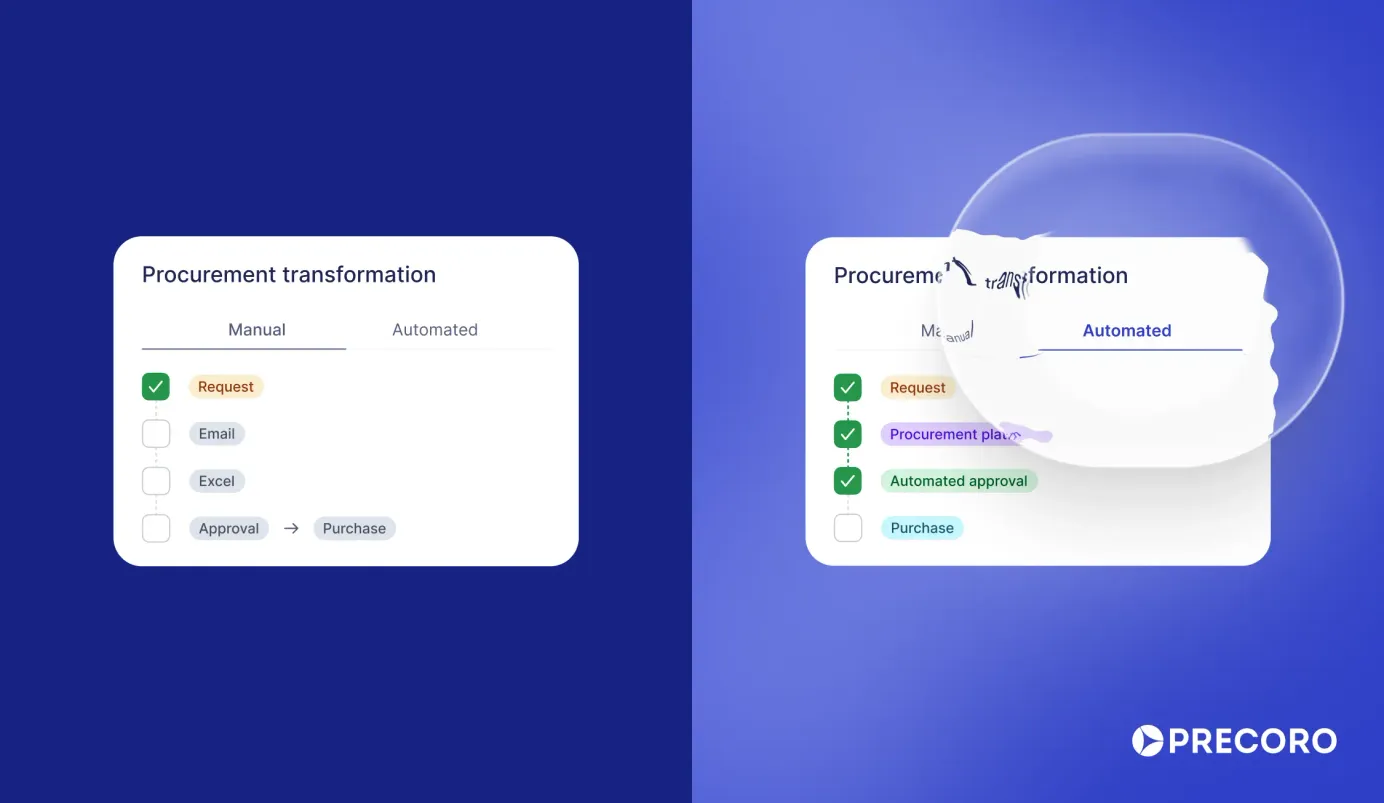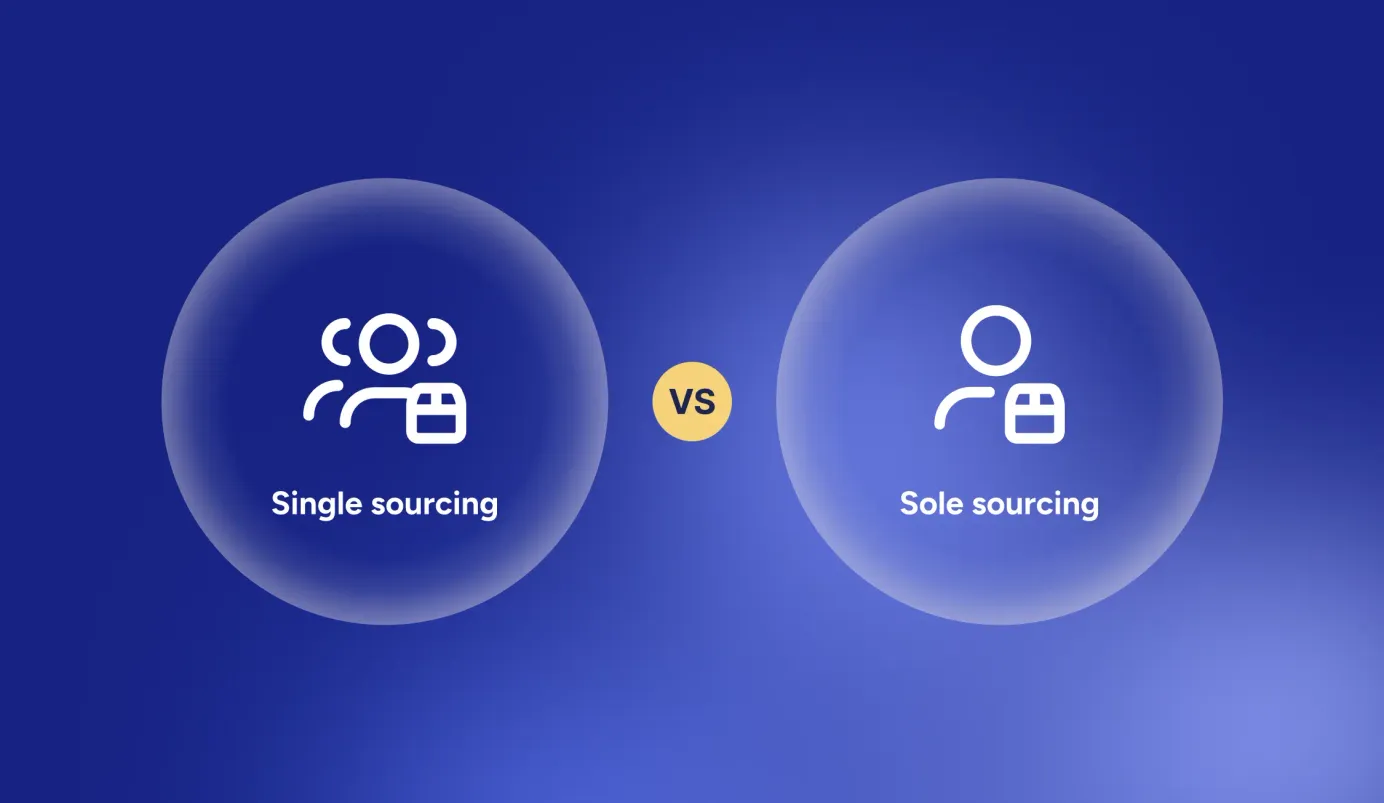
17 min read
How Procurement Automation Benefits Each Step of the Procurement Process
Learn why procurement automation matters more than ever, where it makes the biggest difference, and what issues you’ll encounter.
Procurement is expected to deliver more with less: more savings but tighter budgets, more efficient processes but shorter deadlines and fewer resources. The reason for this shift is mainly procurement automation. AI and cloud-based procurement platforms have become more accessible than ever before. The procurement software market alone is expected to grow to over $18 billion by 2032.
The only solution for executives is to adapt and embrace automation for what it is, a useful tool that can take more work off your team’s plate. In this guide, we’ll explore what automation in procurement is, its key benefits, technologies driving it, and processes worth automating.
Keep reading to find out:
What is procurement automation?
Why switch to automated procurement?
What holds companies back from purchasing automation?
How do you choose a tool for your procurement automation process?
What procurement processes should you automate: Examples and tools
Frequently asked questions about procurement automation
How to achieve automated procurement with Precoro
What is procurement automation?
Procurement automation is the process of using advanced digital tools to manage purchasing activities with minimal manual input. Some organizations prefer automating repetitive, routine tasks, while others experiment with AI to gain strategic insights into the forecast for the next month.
Why switch to automated procurement?
No doubt, manual processes can get the job done but often at a cost. Teams waste hours on tasks that could take minutes, discounts slip out of your grasp, and errors pile up until it’s too late. As companies recognize the issues in their manual processes, automation usually becomes the first stepping stone in their procurement transformation. Here’s what companies gain when they switch from manual to automated procurement:
Measurable cost savings
According to Boston Consulting Group, companies can save anywhere from 15 to 45% by adopting AI across different categories. The biggest savings were found in the IT development and marketing categories. AI adoption alone isn’t enough: your teams need to be constantly upskilled to keep up with the technology, while executives have to make strategic choices on where to implement AI.
Procurement automation helps reduce costs in ways that manual processes simply can’t. By automating your procure-to-pay process, you can minimize manual tasks and errors that can add up to significant cost savings over time. In addition, automated systems for spend analysis can help you flag overspending before it completely drains your budget.
Faster processes
Manual tasks slow teams down and create room for costly mistakes. Procurement automation can reduce purchasing cycle time by up to 50%. It helps deal with bottlenecks in order processing, approval workflows, and vendor management. With less time wasted on repetitive tasks, procurement teams can focus on strategic work and plan for the future, instead of constantly fixing today’s mistakes.
Greater visibility
With an automated system in place, you'll have access to detailed reports on your spending patterns that can help you identify cost-saving opportunities. Automation in procurement shows exactly where the money goes, how suppliers perform, and what stock levels look like across every location and team. AI can also help you catch weak spots early and prepare for risks before they turn into problems.
Stronger compliance control
Instead of relying on trust, use a tool that enforces policies by default. Modern automation systems often offer procurement compliance controls at every step, from supplier selection to final payment. Struggling to keep up with the company-wide spending? Centralized tools show clear audit trails for every transaction.
Want an additional protection layer for your POs? With automated procurement, you can be sure that all purchase orders comply with your company's policies before they're sent to suppliers.
Can’t understand why so many purchases happen off-contract? Procurement automation tools can analyze patterns and identify where rogue purchases happen the most and when. Once you set the rules, these systems automatically notify the team of any unusual transactions. Some tools also use AI to detect fraud patterns or alert you to potential supply chain disruptions.
Improved vendor relations
Automation in procurement works both ways: it makes the entire interaction better for companies and their suppliers alike. Automated systems often include tools for contract management that can help you keep track of your supplier contracts and ensure compliance with their terms and conditions.
Supplier onboarding, a process filled with unnecessary red tape when performed manually, can be done ten times faster with intelligent workflows and smart technology implementation.
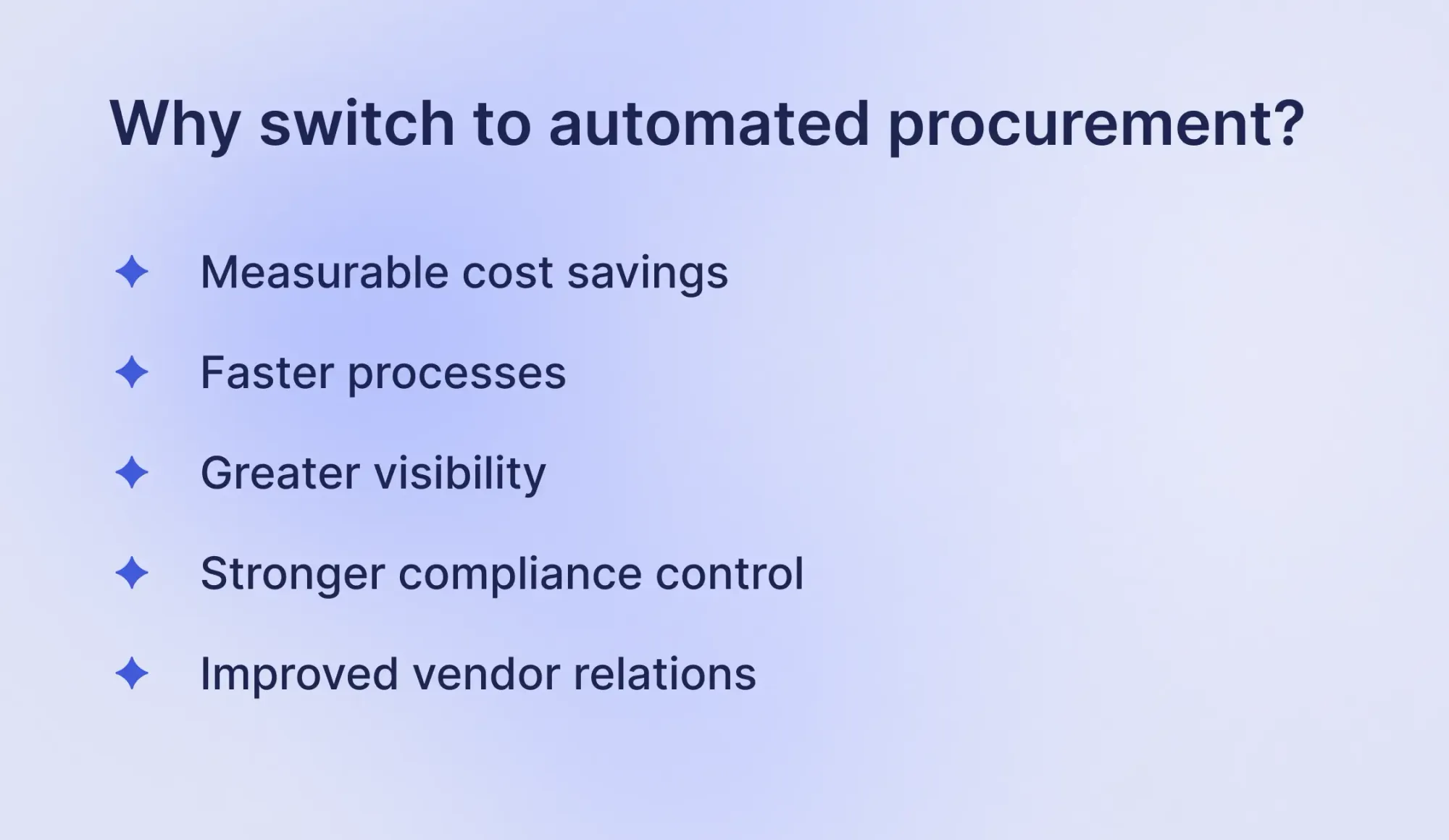
What holds companies back from purchasing automation?
Deloitte's Global Chief Procurement Officer (CPO) Survey found that only 2% of top-performing “Digital Masters” haven’t assessed GenAI adoption yet, compared to nearly 20% of less advanced “Followers.” The numbers are clear on one thing: despite the promising benefits of automation, some companies still run procurement the old way. The reasons usually have less to do with tech but with how their teams operate.
Let’s break down the key factors stopping them from embracing automated procurement to the fullest.
Security concerns
Companies often hesitate to begin the procurement automation process because they’re unsure how secure the tools really are. Procurement often deals with sensitive financial and supplier data. And rightfully so, teams worry about who can access it, how it’s stored, and what might happen if something gets leaked.
These risks seem too big to take, especially for organizations subject to governmental regulations or CSRD guidelines. Even if tools promise high security standards, a simple lack of knowledge of how to deal with sensitive info in an automated environment can have devastating consequences.
Change management
People don’t like changing the way they work, especially when the existing process, no matter how flawed, still gets the job done. Teams often stick with outdated workflows simply because they’re familiar.
Executives worry about pushback against procurement automation, especially if the organization has already tried implementing digital solutions in the past. The idea of retraining staff and introducing new tools can put off employees and even instill fear that they’ll be replaced.
Data quality
The procurement automation process depends on clean, structured, and consistent data. However, if a company is switching from a completely manual process, its data typically isn’t perfect. It may have duplicate records, outdated supplier information, and scattered entries across spreadsheets.
Trying to automate based on bad data can make things worse, not better, especially in the area of spend analysis. If the data is erroneous, any forecast or analysis of the company’s finances is going to steer you in the wrong direction.
For example, the analysis won't show a budget overrun if your data doesn’t include massive emergency expenses. You’ll be blissfully unaware and miss the chance to prevent it from happening again.
Supplier willingness
Internal teams may be ready to adopt procurement automation, but suppliers are often a different story. Some don’t have the tools, time, or interest to change how they interact with their clients. Companies worry that forcing automation too fast might strain relationships if suppliers push back. In some industries or regions, paper-based or informal processes still dominate, which means that switching to digital might be difficult.
Lack of skills
The procurement automation process often demands new skills. The required skillset completely depends on the tools you use. For some, you need little to no tech skills, like with Precoro. For others, like advanced financial forecasting tools, you need to know how to interpret intricate data.
Many organizations hesitate to move forward because they know their team isn’t ready. Hiring and upskilling take time, and the gap between current capabilities and what automation requires feels too big to fill.
Fear of overreliance
Some companies even worry that automation will lead them to lose control over the entire purchasing process. Employees don’t want to become dependent on software, especially if it does some of the decision-making for them. General distrust in technology is also a big factor: they may not trust the system to do its job and feel like the output is fallible.
Integration with other tools
Procurement often has to exchange data with other departments, such as finance, warehouse management, or legal, all of which may use different systems. To avoid data silos and missing important data in reports, you need software that integrates with your existing tools without interrupting your daily routine.
Companies delay automation because a) finding such tools requires time and effort, and b) data sync and initial onboarding might take too long. Key stakeholders fear putting in all that effort, only to find the system isn’t worth it if the lack of data sync disrupts daily operations.
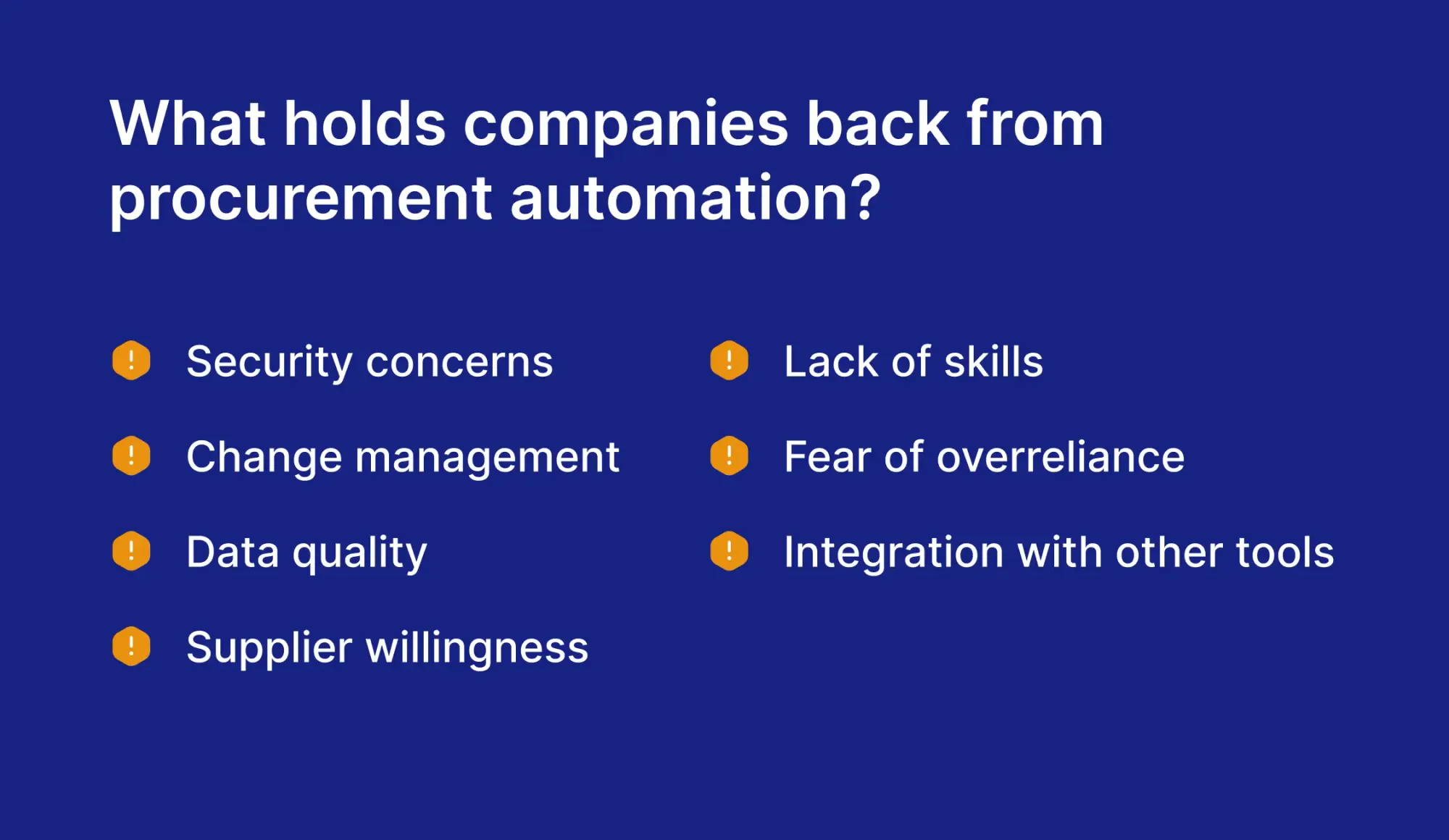
How do you choose a tool for your procurement automation process?
All tools have their selling points, but not all of them will be perfect for you. Here’s a quick guide on how to make sure the procurement automation software is the best match for your needs and purposes:
- Define your pain points and goals.
Identify what’s not working in your current processes and what you’d like to achieve with automation in procurement.
- Involve users who do the work.
Your team will use the tool every day. Ask them what slows them down and what they’d like to improve. Then, address their concerns about how automation can affect their work.
- Research potential candidates.
Target solutions that specifically address your issues. Don’t just focus on the top search results: ask industry peers what they use and research tools tailored for your company size.
- Set up discovery meetings with vendors.
Explain your challenges to the vendor to learn how their tool can help. Schedule a follow-up demo meeting to get a full picture of the features.
- Evaluate each tool’s features.
Focus on features that actually solve your problem and improve your purchasing process. Always need to follow up on approvals? Automate it. Tired of manually entering invoice data? Look for purchasing automation tools that do it for you.
- Check for integrations.
Make sure the tool can sync data with your other existing systems. If it doesn’t, you’ll have to check and re-enter the data yourself.
- Choose usability over “nice to haves”.
Prioritize simple, intuitive platforms over complex dashboards with features your team will use once in a blue moon.
- See what others think.
Check reviews from companies similar to yours on sites like Capterra and G2. Ask vendors for reference calls to get honest feedback from their other customers.
- Consider onboarding and future support.
Don’t just focus on the features, think of how they’ll be implemented and supported in the future. Ask what onboarding looks like, who you can route questions to, and how quickly they respond to issues.
- Pilot before committing.
Some vendors offer free trials or low-commitment short-term options. Test the tool to see how it works for end users in real life.
- Gather feedback and make a decision.
Ask your team and other stakeholders (AP team, suppliers, or department heads) for their feedback. Input from the people who tried the tool is especially valuable: ask them what features helped the most, what was more complicated than it needed to be, and their final thoughts.
Technologies behind procurement automation
Great, you’ve narrowed down the list to tools that best suit your needs. But if you’re still unsure about your perfect match, try to dig deeper and understand what exactly is driving these platforms to perform the way they do. Here are some core technologies that make automated procurement possible:
Robotic Process Automation (RPA)
RPA uses software robots, commonly known as “bots”, to complete rule-based, repetitive tasks. RPA doesn’t learn or adapt; it simply follows rules set prior, which makes it the starting point for automation in procurement. After all, 74% of organizations were already fully implementing RPA in 2022. RPA essentially mimics human actions but is able to do them faster and with fewer mistakes.
Tasks that can be handed over to RPA during the procurement process automation include:
- Data entry and extraction
- Document generation based on extracted info (e.g., contracts, invoices, or POs)
- Automatic PO and PR submission
- Approval routing
- 3-way matching
- Scheduled automated payments
Artificial Intelligence (AI) and its subsets
AI in procurement applies advanced technologies and algorithms to various tasks, usually performed by humans, to make them faster, more efficient, and with additional insight. Instead of simply following the rules like RPA, AI can analyze large datasets and detect patterns.
Most AI used in purchasing automation is weak or narrow AI (meaning it’s built to perform specific tasks). These tools don’t understand language like a human would, but they can process data much faster and highlight things you might miss.
AI is an umbrella term used for a number of technologies. Here are the most common ones:
- Machine Learning (ML) uses algorithms to learn from data and make decisions without explicit programming for each task. The more data it gets, the more it improves its output. ML is often used to identify patterns in spend analysis and predict future demand.
- Natural Language Processing (NLP) enables computers to read, process, and generate human language. In procurement, NLP can be used for supplier communication, such as email and contract drafting, and power customer support chatbots to answer questions like a real person.
- Deep Learning (DL) is an advanced form of ML, which uses neural networks to identify complex patterns in large datasets. Contrary to ML, DL mimics human cognitive abilities, can process unstructured data, and makes autonomous predictions. These tools are mainly used to perform more complex procurement analytics and analyze pricing trends for cost-saving opportunities.
- Generative AI can create new content, such as text, images, and videos, by learning from large amounts of data. Procurement teams mainly use such tools to generate reports from available data, convert PRs to POs, or create predictions.
- Agentic AI is a more autonomous form of AI that can take initiative and perform tasks with limited supervision. Built on generative AI models, agentic AI can draw insights, produce output, and even coordinate with other agents as part of AI orchestration. For example, AI agents can play a key role in procurement process automation and place orders with suppliers if the stock runs low.
Optical Character Recognition (OCR)
OCR converts scanned documents or images into editable, searchable digital text. You don’t need to enter data yourself because the tech does it for you. OCR can be simple (match text to fonts in its internal database and provide output based on that) or intelligent (driven by AI and neural networks to recognize context in a human-like way).
For example, Precoro’s AI-powered OCR for invoice capture understands the document layout: it extracts the key details and matches line items and suppliers to ones in your corresponding purchase order, rather than just blindly scanning invoices and leaving fields empty. It then goes a step further and generates a ready-to-use invoice that’s already tied to the right PO in the system.
OCR has other uses in the procurement automation process besides invoice capture. It comes in handy when paper-based documents need to be converted into digital versions for future use. For example, Precoro also uses OCR to scan receipts for expense reporting on the go. Employees upload a photo of a receipt, and the system scans it and automatically extracts the key details. All you need to do now is double-check the document and submit it for approval.

Cloud-based tools
Cloud-based platforms let companies access procurement software over the internet, without installing or maintaining their own servers. These systems are managed, stored, and accessed in the cloud. Such tools are easier to scale, more affordable to maintain, and accessible from anywhere. Most procurement platforms offer subscription pricing based on the number of users or features.
Cloud-based software covers:
- Centralization of the entire procurement cycle
- Procurement process automation
- Collaboration between teams and suppliers
- Real-time reporting
- Spend tracking
What procurement processes should you automate: Examples and tools
Procurement process automation can improve almost every stage of the procure-to-pay cycle, but that doesn’t mean every little thing must be handed over to digital solutions. Let’s walk through the steps of the purchasing process that will benefit most from automation.
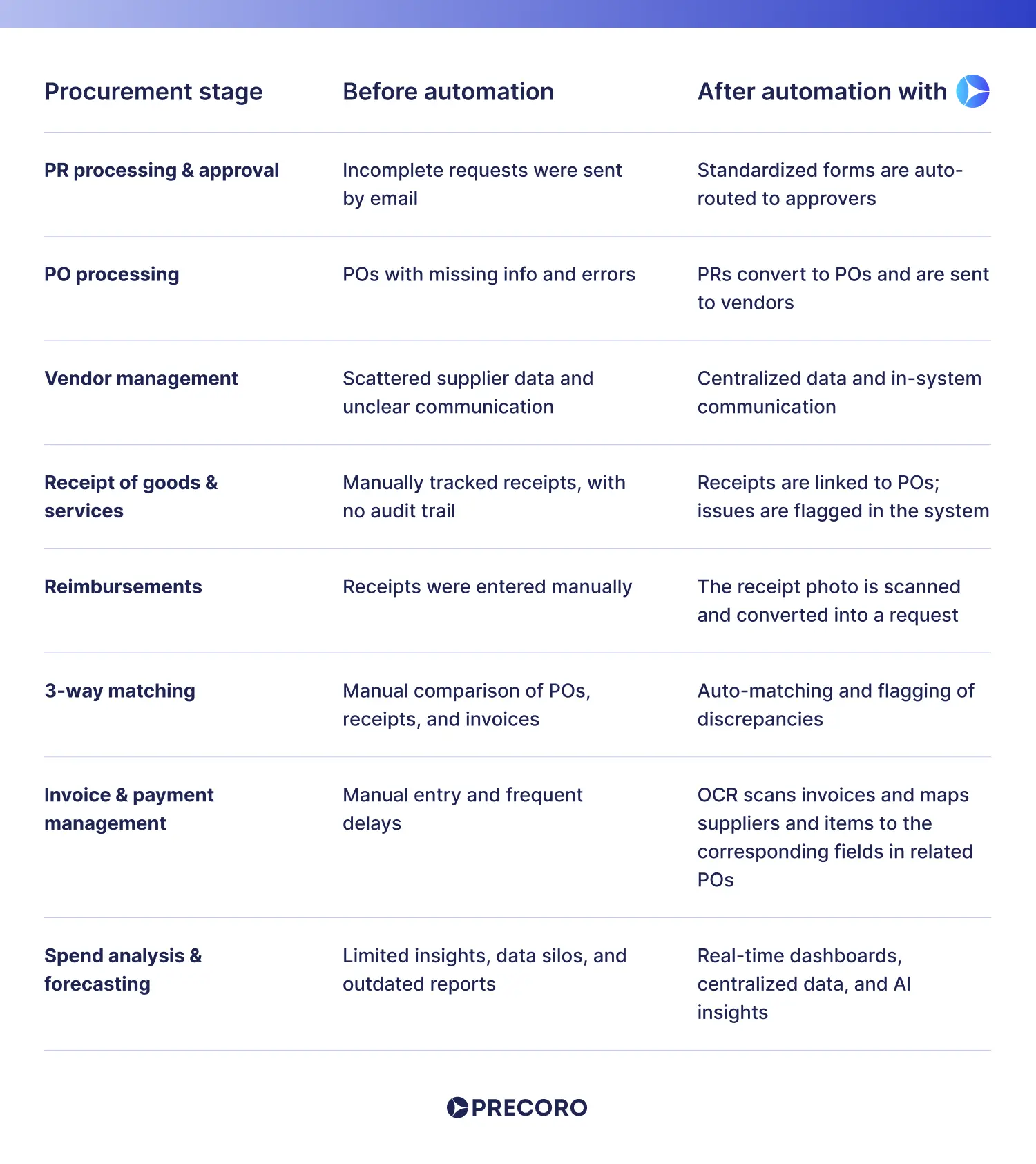
PR processing and approval
Procurement generally begins with purchase requisitions, when employees send requests for something they need. Approval happens throughout the entire purchasing process, but when left untreated, it can weaken the entire transaction from the very start.
Before automation: Employees submitted requisitions through email. The documents were often missing vital information, like requisition number, quantity, preferred delivery date, or vendor details. Approvals took too long and required additional follow-ups to move forward.
After automation: PRs are submitted through centralized software both approvers and submitters have access to. The requests are standardized and can’t be completed without entering all the needed information. After final edits, the document is automatically routed to approvers.
Tools used: Procurement automation software with customizable approval workflows (e.g., Precoro)
PO processing
After a purchase requisition was approved, it’s time to create a purchase order, ideally without re-entering the same data twice.
Before automation: POs were created manually in Word or Excel and had inconsistent formatting and errors. Sometimes they didn’t have all the info from the PR.
After automation: Users can instantly convert approved requests into POs with all the necessary details. Additionally, the system routes them directly to suppliers (if no additional approvals are required).
Tools used: Procurement platforms, ERP systems
Vendor management
Strong procurement relies on up-to-date supplier data and consistent communication, both of which procurement process automation can achieve.
Before automation: Supplier information was scattered across folders, spreadsheets, and multiple email inboxes. Communication with suppliers took days, involved multiple people, and relied on email or messengers.
After automation: All vendor data is stored in one centralized platform. Your team can communicate with suppliers directly in the system and discuss any specific purchase.
Tools used: Vendor management system, Supplier Portal in Precoro
Receipt of goods and services
An automated procurement system can make deliveries a breeze to get through, instead of a communication mess they sometimes are.
Before automation: Employees tracked receipts with manually set reminders. Deliveries were either confirmed through emails or verbally. The team had no consistent paper trail to fall back on.
After automation: Employees enter receipts into a centralized platform and link them to corresponding POs and invoices. If something is damaged or incomplete, they can flag it in the system until the issue is resolved.
Tools used: Procurement software, specifically with warehouse modules
Reimbursements
If employees paid for business expenses out of their own pocket, they submit reimbursement requests to get their money back.
Before automation: Employees submitted paper receipts or sent photos through email, which the team then had to re-enter themselves. Employees had to wait weeks to get paid back, and finance teams spent hours checking each request.
After automation: Employees upload a photo of their receipt or snap a picture on their phone. The system extracts key info automatically and creates a request that’s ready for approval. Once the final edits are made, the document is routed to approvers.
Tools used: Spend management software, AI-powered expense creation in Precoro
3-way matching
During 3-way matching, the AP team matches the PO, invoice, and receipt to confirm that all details are correct on all documents.
Before automation: Employees compared documents line by line and missed typos or price errors. The process took hours when multiple orders were involved.
After automation: The system automatically matches all documents and notifies the team of any discrepancies.
Tools used: AP automation software
Invoice and payment management
Procurement automation helps ensure suppliers get paid on time, while your team doesn’t spend hours entering invoices.
Before automation: The AP teams entered invoice data manually and made errors in spelling or numbers. Approvals were stalling, which led to late payments. These, in turn, damaged vendor relationships.
After automation: OCR scans invoices and auto-matches them to POs. Additionally, Precoro also offers a human review to double-check pre-filled invoices for some customers. Afterward, the system routes them for approval. Once approved, invoices are sent to the AP team for payment.
Tools used: OCR for invoice capture, AP automation tools
Spend analysis and forecasting
Use available procurement data to understand the company’s spending patterns and future issues it may run into.
Before automation: Data was scattered between spreadsheets and different tools. Finance didn’t have access to procurement data, and vice versa. Teams had to analyze data manually or use outdated tools that missed key insights.
After automation: All data is stored in one system. Real-time dashboard shows spend by supplier, category, or location. AI analyzes the data and spots patterns and anomalies.
Tools used: AI-powered spend analysis and forecasting tools, predictive analytics
Frequently asked questions about procurement automation
Procurement automation refers to the use of digital tools (AI, OCR, and cloud-based platforms) to handle repetitive tasks throughout the procure-to-pay process. It’s often used to make manual steps like 3-way matching and data entry faster and more efficient, which frees up employees to do strategic tasks only humans can do.
To automate purchase requisitions, companies turn to digital procurement software that employees can use to submit requests. Such tools often include standardized forms and enforce mandatory fields, without which the requisition won’t be sent. Then, the PR is automatically routed to the right approvers.
In supply chain management, automation refers to using digital tools to make sourcing, procurement, logistics, and inventory operations more efficient. It can include everything from AI-powered demand forecasting and vendor selection to automated shipment tracking.
One example of purchasing automation is automated three-way matching: instead of manually comparing purchase orders, receipts, and invoices, you let the system check all documents and flag any mismatches.
Look for tools that solve your current pain points and ones your team will realistically use. Focus on the following factors:
- Usability for your team
- Integration with your existing systems
- Future support and onboarding
- Real use cases and customer reviews
- Feedback from the end users after the first real-life use
How to achieve automated procurement with Precoro
Precoro helps companies automate key procurement workflows from day one. Here are some features you can already take advantage of:
- Automated 3-way matching. Your team shouldn’t have to waste hours comparing the details of each document line by line. Precoro automatically matches invoices, receipts, and POs within 30 seconds.
- AI-driven OCR. Powered by Google AI, OCR considers the document’s layout, extracts the key details, and generates an in-system invoice with pre-filled info. If you’re still unsure, opt for an optional human review to confirm the details.
- AI expense reporting. Employees upload a receipt photo, and Precoro creates a reimbursement request, ready for approval.
- Approval workflow automation. After you set up custom approval workflows, the system will route each document to the right people without having to follow up.
- Customizable reports. Generate a report or visual chart of your spend by department, supplier, or budget with tailored templates.
- Automatic PR to PO creation. No copy-pasting. Turn the approved purchase requisition into a purchase order with one click.
There’s more to come. More automation features are in the works, all designed to make procurement more transparent for you and more manageable for your team.


